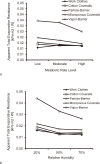Prediction of WBGT-based clothing adjustment values from evaporative resistance
- PMID: 29033404
- PMCID: PMC5718775
- DOI: 10.2486/indhealth.2017-0121
Prediction of WBGT-based clothing adjustment values from evaporative resistance
Abstract
Wet bulb globe temperature (WBGT) index is used by many professionals in combination with metabolic rate and clothing adjustments to assess whether a heat stress exposure is sustainable. The progressive heat stress protocol is a systematic method to prescribe a clothing adjustment value (CAV) from human wear trials, and it also provides an estimate of apparent total evaporative resistance (Re,T,a). It is clear that there is a direct relationship between the two descriptors of clothing thermal effects with diminishing increases in CAV at high Re,T,a. There were data to suggest an interaction of CAV and Re,T,a with relative humidity at high evaporative resistance. Because human trials are expensive, manikin data can reduce the cost by considering the static total evaporative resistance (Re,T,s). In fact, as the static evaporative resistance increases, the CAV increases in a similar fashion as Re,T,a. While the results look promising that Re,T,s can predict CAV, some validation remains, especially for high evaporative resistance. The data only supports air velocities near 0.5 m/s.
Keywords: Clothing; Clothing adjustment value; Evaporative resistance; Thermal stress; WBGT.
Figures



Similar articles
-
Apparent evaporative resistance at critical conditions for five clothing ensembles.Eur J Appl Physiol. 2008 Sep;104(2):361-7. doi: 10.1007/s00421-007-0655-9. Epub 2008 Jan 3. Eur J Appl Physiol. 2008. PMID: 18172671
-
Measurements of clothing evaporative resistance using a sweating thermal manikin: an overview.Ind Health. 2017 Dec 7;55(6):473-484. doi: 10.2486/indhealth.2017-0052. Epub 2017 Jun 1. Ind Health. 2017. PMID: 28566566 Free PMC article. Review.
-
Effect of sweating set rate on clothing real evaporative resistance determined on a sweating thermal manikin in a so-called isothermal condition (T manikin = T a = T r).Int J Biometeorol. 2016 Apr;60(4):481-8. doi: 10.1007/s00484-015-1029-3. Epub 2015 Jul 7. Int J Biometeorol. 2016. PMID: 26150329
-
Heat stress risk profiles for three non-woven coveralls.J Occup Environ Hyg. 2018 Jan;15(1):80-85. doi: 10.1080/15459624.2017.1388514. J Occup Environ Hyg. 2018. PMID: 29053928
-
Clothing evaporative heat resistance--proposal for improved representation in standards and models.Ann Occup Hyg. 1999 Jul;43(5):339-46. Ann Occup Hyg. 1999. PMID: 10481633 Review.
Cited by
-
Psychrometric limits and critical evaporative coefficients for exercising older women.J Appl Physiol (1985). 2020 Aug 1;129(2):263-271. doi: 10.1152/japplphysiol.00345.2020. Epub 2020 Jun 18. J Appl Physiol (1985). 2020. PMID: 32552432 Free PMC article.
-
ClimApp-Integrating Personal Factors with Weather Forecasts for Individualised Warning and Guidance on Thermal Stress.Int J Environ Res Public Health. 2021 Oct 28;18(21):11317. doi: 10.3390/ijerph182111317. Int J Environ Res Public Health. 2021. PMID: 34769832 Free PMC article.
-
New development of research on personal protective equipment (PPE) for occupational safety and health.Ind Health. 2017;55(6):471-472. doi: 10.2486/indhealth.55-471. Ind Health. 2017. PMID: 29212988 Free PMC article. No abstract available.
References
-
- ACGIH® (2016) Heat Stress and Strain TLV®, in Threshold Limit Values and Biological Exposure Indices for Chemical Substances and Physical AgentsACGIH®: Cincinnati, OH.
-
- Jacklitsch B, Williams WJ, Musolin K, Coca A, Kim J-H, Turner N NIOSH criteria for a recommended standard: occupational exposure to heat and hot environments. NIOSH.
-
- International Organization for Standardization (ISO) (1989) ISO7243: Hot environments—Estimation of the heat stress on working man, based on the WBGT-index (wet bulb globe temperature)Geneva: ISO.
-
- Garzon-Villalba XP, Wu Y, Ashley CD, Bernard TE (2017) Ability to Discriminate Between Sustainable and Unsustainable Heat Stress Exposures-Part 1: WBGT Exposure Limits. Annals of work exposures and health. - PubMed
-
- Ramsey JD. (1978) Abbreviated guidelines for heat stress exposure. Am Ind Hyg Assoc J 39, 491–5. - PubMed
MeSH terms
Grants and funding
LinkOut - more resources
Full Text Sources
Other Literature Sources

